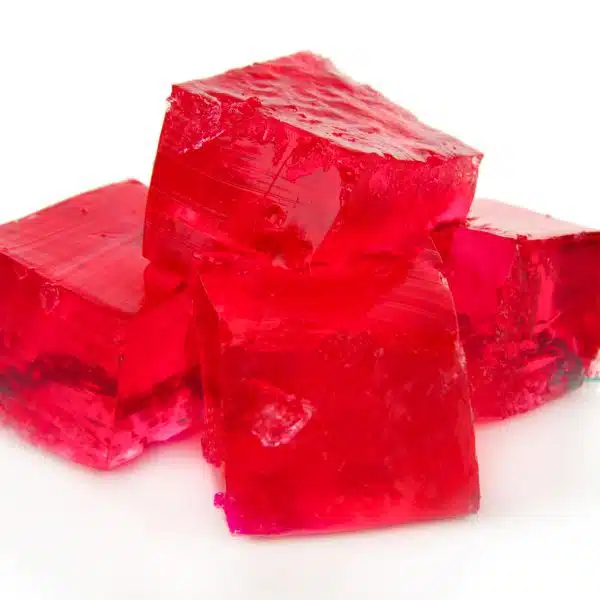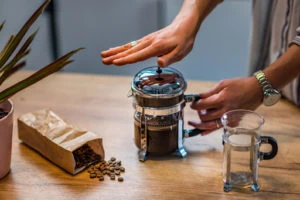Jello, whether plain or fruit-filled, is one of those treats you can always count on when the holidays arrive. With that in mind, how long does Jello last after those special days and can you stretch out your time with this jiggly treat?
Well, commercial-sealed Jello packs will last up to 3 months unopened in your pantry and 12 to 18 months in your refrigerator. Homemade Jello, by contrast, is only good for 7 to 10 days in your refrigerator and a mere 4 hours at room temperature – although that’s just plain Jello, if you’ve added fruit then it’s best eaten within 3 to 4 days. It’s not recommended that you freeze it, either, for reasons we will go into later in this article.
If you’ve ever wondered about Jello and its shelf-life, then today is your lucky day. In this article, we’ll talk about what’s inside this classic gelled-juicy snack, the best ways to store it to get a little more shelf-life, and how to tell if your Jello is better off in your trash bin than in your bowl.
Whether it’s jello shots, jello cup, homemade jello, or jello salad, let’s talk about Jello and how long it lasts!
What’s in Jello? Understanding its shelf life

Jello is a colloid, which is to say that from a scientific standpoint, it’s a semi-rigid structure that is suspended inside of a liquid, and its use as a treat dates all the way back to the early 1800s. In 1822, a fellow named Peter Cooper purchased a glue factory, where they had been experimenting with various things they could make with animal by-products.
By 1945, he’d patented a ‘portable gelatin dessert’ but it wasn’t really that appealing – it was all jiggle, but no flavor. Fast-forward to 1897 in New York and the original Jell-o was trademarked by one Pearle Bixby Wait and his wife, May, and this time they’d done things right – it came with sugar and flavors like raspberry, strawberry, orange, and lemon.
While you may have heard rumors that Jello is made from hooves, this is actually not the case. Gelatin is derived from pork, pork skins, and cattle bones, but hooves are actually made of keratin – the same stuff your fingernails are made of – so they won’t be used for making gelatin.
These days, however, there are even vegetarian Jello varieties, but from a preservative standpoint, they’re pretty much the same. The gelatin powder itself is practically immortal – while it’s recommended that you use it within 2 to 3 years, people have used gelatin powder that’s 20 to 25 years old and it still came out perfectly.
That said, at its basic, we’re talking about animal parts (in most cases), sugar, and artificial flavoring, produced by heating a liquid mixing it in your gelatin packet, and then letting it cool. While it has the ability to stay fresh for many months inside of a sealed, plastic container and refrigerated, at room temperature it will still go bad in about 4 hours.
So, what kind of storage options do you have with Jello? Let’s take a look!
What is the best way to store Jello?

With Jello, you are actually quite limited in how you can store it because that colloidal state is easy to upset. In this section, we’ll look at different common preservation methods so that you can get a glimpse at the associated problems and have a better understanding of the shelf-life overall.
Refrigeration
The refrigerator is your best and really, ONLY option when it comes to preserving Jello in its yummy, jiggly state. We’d mentioned that the colloidal state is kind of a scientific ‘balancing act’ and this is definitely the case. Storing your Jello in a sealable, plastic container is going to get you 5 to 7 days of storage, or 3 to 4 days if fruits are suspended inside.
With the fruits, you’re dealing with their own ‘timetable of decay’, as the fruit will have come in contact with the air and any microorganisms around before being added to your Jello. While the heat of the liquid, before it cools to a colloidal state, may kill some of them, it won’t get everything, and eventually, the fruit will start to go bad, creating liquid as it does and upsetting the rigid structure and taste of the Jello.
Sadly, there aren’t really any hacks to stop this – while you could certainly store the fruit separately and layer it under Jello, it just doesn’t have the same aesthetics or taste the same as when it’s suspended.
So, what about freezing Jello?
Freezing
Freezing Jello is certainly possible, although the only way it’s going to come out all wiggly is if you are making Jello shots. That’s because the alcohol in the shots prevents freezing. On its own, regular Jello can certainly be frozen, but that delicate colloidal state will become imbalanced in the process.
Remember – it’s a suspension inside a liquid – and liquids tend to crystallize as they freeze. What this produces, then, if you freeze Jello, is basically a mess of small blobs that you’ll get when you thaw it out and that’s really a BEST-CASE scenario.
Some things you can’t really freeze, unfortunately, and Jello is one of those rare exceptions to the norm of ‘put it in the freezer and it’ll be fine later’ – it simply cannot withstand the changes brought upon it by cold.
You can still enjoy the flavor by freezing it and then running it through a blender, but you’re just going to be enjoying Jello-flavored slush!
Vacuum sealing
Vacuum sealing is another tried and true option that works for just about anything – but not Jello.
Probably the best way to describe what you’ll get is to evoke a memory that we’ve all had enjoying delicious Jello treats. At some point, you’ve gotten curious and squished it with a spoon to see just how much pressure it took to remove that perfect little cube form and then you found out that it doesn’t take much.
When you pop some Jello into a vacuum sealer bag and let the machine do its thing, the air will get quickly pulled out of the bag and the bag is going to contract. This will act much like the spoon-smooshing experiments of your youth, and you end up with squished-up Jello.
It’s not ideal, to say the least. Now, there is one interesting option for preserving Jello that will preserve it in a different state and which might appeal to you for the novelty and taste – you can freeze-dry it.
Freeze drying
The internet has introduced us to all kinds of amazing and amazingly weird things, and one little gem that we wanted to share with you is freeze-dried Jello. If you have a freeze drier and don’t mind popping Jello inside it for around 24 hours, then what you’ll get is a dried Jello snack that has twice the sweetness and flavor of the amount of Jello that you put into it.
Mind you – this is a step only for the most hardcore Jello fans – but if you are so inclined, you could make these, vacuum seal them, and have Jello-flavored snacks for months. Also, you should probably share them with the kids, as we’ve heard that they absolutely LOVE these snacks.
You can find out more about how to make these delights by visiting Freeze Dried Guide for a step-by-step of the process. It’s not your average, everyday storage method, but it sure is a flavorful and creative one that might just prove to be your new favorite snack!
They’re crunchy, they melt in your mouth, and they taste more like Jello than actual Jello – all from freeze-drying. Who woulda thought?!
As always, thanks to the Internet for keeping things fun and weird!
How do you know when Jello has gone bad?

Telling when Jello has gone bad is actually easier than you might think.
Since it’s a colloid, just looking at it is often enough, as perfect jiggly cubes usually mean that it’s intact, but it’s still a good idea to always check. Here are some common-sense basics to look for:
- Odor – Jello doesn’t really have much of a smell to it and that’s the way it should be. A light hint of sweetness, perhaps, and maybe a tang if it’s a flavor like lime are usually the best that you can expect. If it suddenly has ANY kind of exaggerated or weird odor, then it’s time to throw it out!
- Appearance – Changes in appearance are a big red flag and there are lots of different kinds. Old, for instance, is a definite ‘throw out the Jello’ scenario, even if it’s only on a corner. Any sort of discoloration is also a bad sign, be it the Jello or with some fruit suspended inside. Finally, Jello ‘sweats’ as it degrades, so if it’s started getting watery, then it’s time to get rid of that Jello and make a fresh batch if you simply have to have it today!
- Texture – Jello’s texture is a big part of that signature flavor, and if it’s gone from neat little shaky cubes to something more like a collection of blobs, then it’s probably gone bad and you need to throw it in the trash.
FAQs
While we try to be as comprehensive as possible, it’s inevitable that some interesting facts are going to slip ‘down the drain’ along the way. With that said, to help minimize this little problem, we’ve got a few frequently asked questions to share with you before we officially ‘call it a day’.
We hope that you’ll find this information useful, so here are those questions and if you find something interesting, then it’s yours to keep!
Does Jello go bad if not refrigerated?
You can put Jello out for up to 4 hours before you really need to worry, so if you want to take advantage of the aesthetics then just keep it in the refrigerator until it’s time to display it and you should still have plenty of time to store it again later.
Keep in mind that we’re talking about room temperature here, though. If the AC is out and the temperature is high, it’s really best not to keep the Jello out for more than an hour or two as the bacteria and microorganisms will be much more active when it’s hot inside.
How long are Jello shots good for?
Jello shots will be kept for 3 to 5 days, provided that you’re storing them in glass. That’s because glass will transfer heat a little more slowly than plastic, so just keep this in mind the next time that you are making them and you’ll have your best chances at that 3-5 day storage time.
Can bacteria really grow on gelatin?
Yes, bacteria can grow on all kinds of things, although the types of organisms you’ll usually get are going to be the bacteria that can convert gelatinase into proteins to gobble up. Bacteria are cultured in gelatin in Petri dishes in labs all over the world and even at home when kids are doing science experiments, although usually this is done by adding a little beef broth so that the cultures can chow down and multiply.
So, while Jello looks pretty unassailable, bacteria can actually grow there just fine – moving it to the refrigerator quickly is your best defense.
For those of you who perked up at the mention of Freeze-dried Jello, here’s a little video from Adventures in Freeze Drying that will tell you all about it and how it’s done!
In Conclusion
In this article, we’ve answered the question ‘how long does Jello last?’ and in a nutshell, you’ll get 4 hours at room temperature before it goes bad, 7 – 10 days in the refrigerator in a sealed plastic or glass storage for plain Jello, or 3 – 4 days in the fridge for Jello with suspended fruit in it.
Sadly, refrigeration is really your only option for keeping the Jello at its usual consistency. Freezing will damage the colloidal properties and vacuum sealing will just smush it. You could freeze-dry it as a treat, but that one is up to you – if Jello is your favorite treat, it comes highly recommended, but it may be too much work for the average Jello fan.
If you have some comments or tricks that we’ve missed, we sure would love to hear them, so be sure to check the feedback and join the Jello conversation to share some of those gems with the rest of us. Until next time, thanks so much for visiting, and we hope to see you again soon!





David learned to cook at an early age after his mother told him that he couldn't live on pizza forever, Dave uses his modest kitchen skills to recreate sorely-missed recipes from home and to occasionally make new favorite ones from places he is visiting.